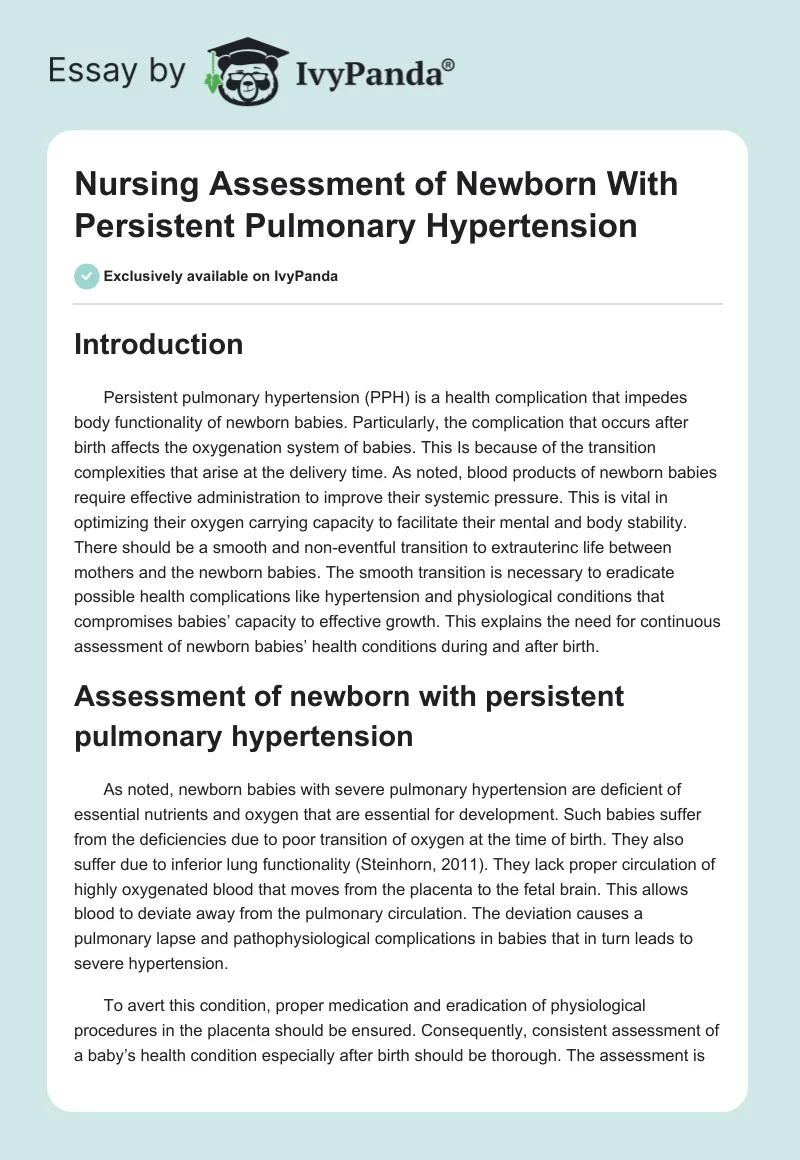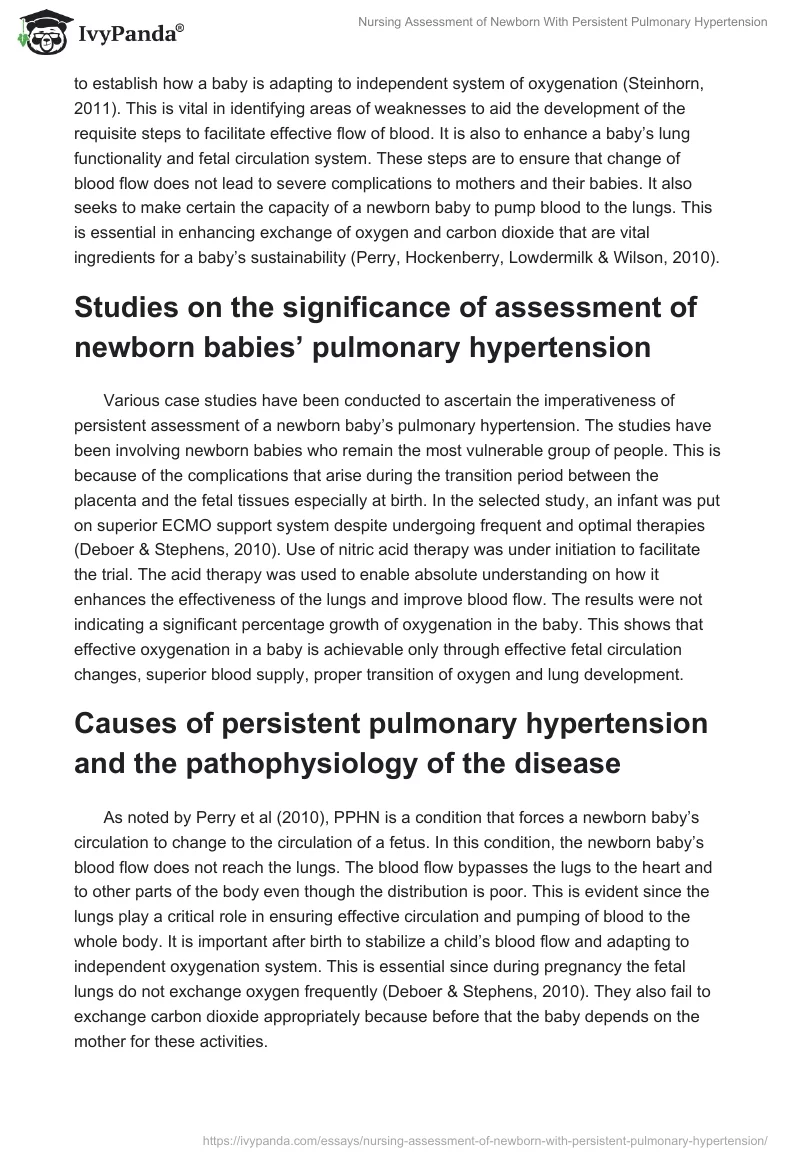Introduction
Persistent pulmonary hypertension (PPH) is a health complication that impedes body functionality of newborn babies. Particularly, the complication that occurs after birth affects the oxygenation system of babies. This Is because of the transition complexities that arise at the delivery time. As noted, blood products of newborn babies require effective administration to improve their systemic pressure. This is vital in optimizing their oxygen carrying capacity to facilitate their mental and body stability. There should be a smooth and non-eventful transition to extrauterinc life between mothers and the newborn babies. The smooth transition is necessary to eradicate possible health complications like hypertension and physiological conditions that compromises babies’ capacity to effective growth. This explains the need for continuous assessment of newborn babies’ health conditions during and after birth.
Assessment of newborn with persistent pulmonary hypertension
As noted, newborn babies with severe pulmonary hypertension are deficient of essential nutrients and oxygen that are essential for development. Such babies suffer from the deficiencies due to poor transition of oxygen at the time of birth. They also suffer due to inferior lung functionality (Steinhorn, 2011). They lack proper circulation of highly oxygenated blood that moves from the placenta to the fetal brain. This allows blood to deviate away from the pulmonary circulation. The deviation causes a pulmonary lapse and pathophysiological complications in babies that in turn leads to severe hypertension.
To avert this condition, proper medication and eradication of physiological procedures in the placenta should be ensured. Consequently, consistent assessment of a baby’s health condition especially after birth should be thorough. The assessment is to establish how a baby is adapting to independent system of oxygenation (Steinhorn, 2011). This is vital in identifying areas of weaknesses to aid the development of the requisite steps to facilitate effective flow of blood. It is also to enhance a baby’s lung functionality and fetal circulation system. These steps are to ensure that change of blood flow does not lead to severe complications to mothers and their babies. It also seeks to make certain the capacity of a newborn baby to pump blood to the lungs. This is essential in enhancing exchange of oxygen and carbon dioxide that are vital ingredients for a baby’s sustainability (Perry, Hockenberry, Lowdermilk & Wilson, 2010).
Studies on the significance of assessment of newborn babies’ pulmonary hypertension
Various case studies have been conducted to ascertain the imperativeness of persistent assessment of a newborn baby’s pulmonary hypertension. The studies have been involving newborn babies who remain the most vulnerable group of people. This is because of the complications that arise during the transition period between the placenta and the fetal tissues especially at birth. In the selected study, an infant was put on superior ECMO support system despite undergoing frequent and optimal therapies (Deboer & Stephens, 2010). Use of nitric acid therapy was under initiation to facilitate the trial. The acid therapy was used to enable absolute understanding on how it enhances the effectiveness of the lungs and improve blood flow. The results were not indicating a significant percentage growth of oxygenation in the baby. This shows that effective oxygenation in a baby is achievable only through effective fetal circulation changes, superior blood supply, proper transition of oxygen and lung development.
Causes of persistent pulmonary hypertension and the pathophysiology of the disease
As noted by Perry et al (2010), PPHN is a condition that forces a newborn baby’s circulation to change to the circulation of a fetus. In this condition, the newborn baby’s blood flow does not reach the lungs. The blood flow bypasses the lugs to the heart and to other parts of the body even though the distribution is poor. This is evident since the lungs play a critical role in ensuring effective circulation and pumping of blood to the whole body. It is important after birth to stabilize a child’s blood flow and adapting to independent oxygenation system. This is essential since during pregnancy the fetal lungs do not exchange oxygen frequently (Deboer & Stephens, 2010). They also fail to exchange carbon dioxide appropriately because before that the baby depends on the mother for these activities.
Indeed, poor blood circulation and exchange of oxygen remains the key cause of PPHN in children. It lowers a baby’s capacity to recording effective blood circulation and proper fetal oxygenation that is needed for effective growth. Other causes include poor transition of oxygen transmission systems from the placenta to the fetal system and weak lungs. These causes are eminent at birth when a newborn baby must make a circulation change of blood from fetal to postnatal circulation. The effectiveness of the processes required physiological support in the uterus and pulmonary vasodilation. However, pathophysiology needed transition incentives must now reduce quickly to aid effective lung functioning (Deboer & Stephens, 2010). This would ensure proper transition process, circulation of blood, oxygen and functionality of the lungs.
Conclusion
Indeed, continuous assessment of newborn babies is crucial to facilitate their wellbeing. The assessment helps in establishing any complication that may compromise the transition process of a baby in prior. It is also important in establishing possible complications in the placenta and burden of oxygenation. Therefore, health officials and parents should adopt the concept with an aim of enhancing the wellbeing of newborn babies.
References
Deboer. S. & Stephens, D. (2010). Persistent Pulmonary Hypertension of the New Born: Case Study and Pathophysiology Review. Web.
Perry, S., Hockenberry M., Lowdermilk, D., & Wilson, D. (2010). Maternal Child Nursing Care. Maryland Heights, MO: Mosby.
Steinhorn, R. (2011). Persistent Newborn Pulmonary Hypertension. Web.


